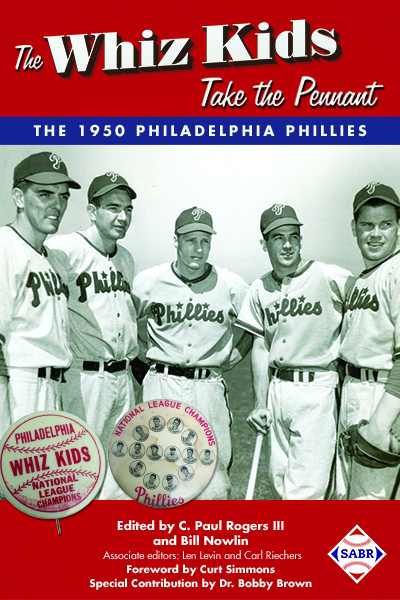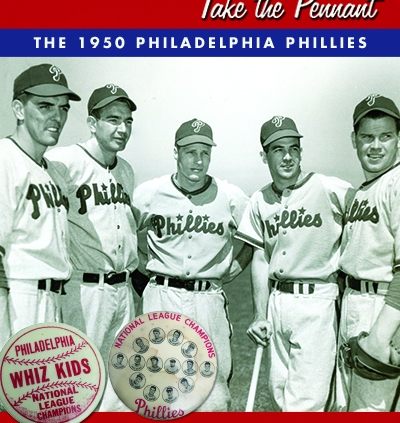Andy Skinner: Jim Konstanty’s Undertaker Pitching Coach
This article was written by C. Paul Rogers III
This article was published in 1950 Philadelphia Phillies essays
 It is highly unlikely that the Philadelphia Phillies would have won the 1950 National League Pennant without reliever Jim Konstanty, who was so dominant that he was named the National League’s Most Valuable Player. And so it is worthwhile to consider whether Konstanty would have won the MVP and had the year he had without the assistance of his private pitching coach, an undertaker named Andy Skinner who had never played baseball.
It is highly unlikely that the Philadelphia Phillies would have won the 1950 National League Pennant without reliever Jim Konstanty, who was so dominant that he was named the National League’s Most Valuable Player. And so it is worthwhile to consider whether Konstanty would have won the MVP and had the year he had without the assistance of his private pitching coach, an undertaker named Andy Skinner who had never played baseball.
Skinner grew up in the small town of Worcester, New York, diagonally across the street from the house that Mary Burlingame, Jim Konstanty’s wife, grew up in. The two men became friendly during the Konstantys’ visits there in the offseason and Skinner would sometimes ride with Konstanty to places like Utica to watch Jim play semipro basketball.1 Skinner had a very analytical mind and had taken up bowling a few years before with some friends when a new alley opened in town. He sent away for instruction books on bowling and after studying them went from the worst bowler among his friends to the best bowler.2
Konstanty had struggled in 1946, briefly with the Boston Braves, and then, after being sold to Toronto, with the Maple Leafs, where he went 4-9. Konstanty was uncertain about his baseball future and during their trips to basketball games that winter he and Skinner began to talk about pitching. Skinner was a good listener and wondered aloud whether what he had learned about putting spin on a bowling ball could be put to use with a baseball. Shortly thereafter, Konstanty began throwing to Skinner as Andy studied his grip and the spin on the ball. Skinner likened wind resistance to the friction on a bowling alley and applied the same spin principles that had improved his bowling. Over time he was able to alter Konstanty’s grip and improve the spin on his palmball, which Konstanty used as a changeup, and his slider; and the pitches became much more effective.3
Konstanty improved to 13 wins the following year with Toronto and continued to work with Skinner in the offseason on his palmball and slider. When he hit a pitching slump during the season, he called Skinner to Toronto to tell him what he was doing wrong. Once, the Maple Leafs even put Skinner in uniform.4
Konstanty was called back to the big leagues in late 1948 and had a strong season with the improving Phillies in 1949, winning 9 against 5 losses with a 3.25 earned-run average in 53 relief appearances. Before that season Skinner erected a television antenna on a high hill near Oneonta, New York, near Worcester, which enabled him to get the Phillies games on foggy nights. He could also receive the Giants and Dodgers games and when he noticed something in Konstanty’s delivery he would simply call him and explain what he saw.5
In 1950, Konstanty experienced a slump after the All-Star break and struck out only two batters in 15 innings in nine appearances between July 8 and July 26.6 He called Skinner, who arrived in Philadelphia the next day, went to the ballpark, took off his jacket, and began to watch Konstanty throw in the bullpen.7 He soon noticed that Konstanty had changed the release point on his slider, which meant that it didn’t have much bite on it. All of a sudden, Konstanty again became almost unhittable.8
Konstanty was always quick to give credit to Skinner, saying, “Andy Skinner is not just a good story. He is my bread and butter.”9 On another occasion after the 1950 season, Konstanty said, “The big difference between my pitching for Toronto in 1946 and my pitching today is Andy Skinner.”10
It is not much of a stretch to say that without Andy Skinner, an undertaker who initially didn’t know a slider from a fastball, Jim Konstanty would not have become the dominant relief pitcher that he did in 1950. And without Konstanty’s 16 wins and 152 innings in 74 relief appearances there would have been no pennant for the Whiz Kids that year. Thus, it really is true that Andy Skinner, an unpaid, unofficial sometime pitching coach who had never played baseball, was a key to the Phillies’ pennant run.11
PAUL ROGERS is co-author of several baseball books including The Whiz Kids and the 1950 Pennant (Temple University Press, 1996) with boyhood hero Robin Roberts, and Lucky Me: My 65 Years in Baseball (SMU Press 2011) with Eddie Robinson. Paul is president of the Ernie Banks – Bobby Bragan DFW Chapter of SABR and a frequent contributor to the SABR BioProject, but his real job is as a law professor at Southern Methodist University, where he served as dean of the law school for nine years. He has also served as SMU’s faculty athletic representative for 30 years.
Notes
1 Later they, with others, also went on moose hunting trips to northern Ontario. Letter from Mary Konstanty to author, dated August 25, 1995, on file with author.
2 Ed Pollock, “Undertaker Gives Him New Life,” Baseball Digest, November 1950: 16.
3 Andy Duncan, “Jim Konstanty – The All-Time Fireman,” Sport, May 1951: 19, 93; Stan Baumgartner and Harry T. Paxton, “He Pitched the Phillies to the Pennant,” Saturday Evening Post, January 13, 1951: 99.
4 Robin Roberts and C. Paul Rogers III, The Whiz Kids and the 1950 Pennant (Philadelphia: Temple University Press, 1996), 143-44.
5 Baumgartner and Paxton: 99.
6 Pollock: 16.
7 Andy Seminick later recalled catching Konstanty on the sidelines with Andy Skinner watching. After a pitch, Konstanty would ask, “How was that one, Andy?” Seminick would answer him but then realize that Konstanty was talking to Skinner, not him. Roberts and Rogers, 145.
8 Roberts and Rogers, 144; Pollock, 16; Frank Yeutter, Jim Konstanty (New York: A.S. Barnes & Company, 1951), 52-54. On another occasion Skinner attended a game in the Polo Grounds where the Phillies were playing the New York Giants. He had driven a hearse into the city because he had to pick up a body later. He offered Konstanty a ride back to the hotel after the game and Robin Roberts, Curt Simmons, and Russ Meyer came along as well. Since there wasn’t room in front, the three of them had to ride in the back where the caskets are. They caused quite a scene when the hearse pulled up in front of the Commodore Hotel and three large and very alive men piled out of the back. Roberts and Rogers, 144-45.
9 Jim Konstanty notes in 1950, written for Frank Yeutter biography of Jim Konstanty, on file with author.
10 Duncan: 93.
11 Phillies manager Eddie Sawyer invited Skinner to spring training in 1951 and gave him a uniform. Roberts and Rogers, 145. Konstanty continued to call on Skinner when he slumped early in the 1951 season. Barney Nagler, “Pop’s In There Pitching,” Redbook, August 1951: 28, 83.


